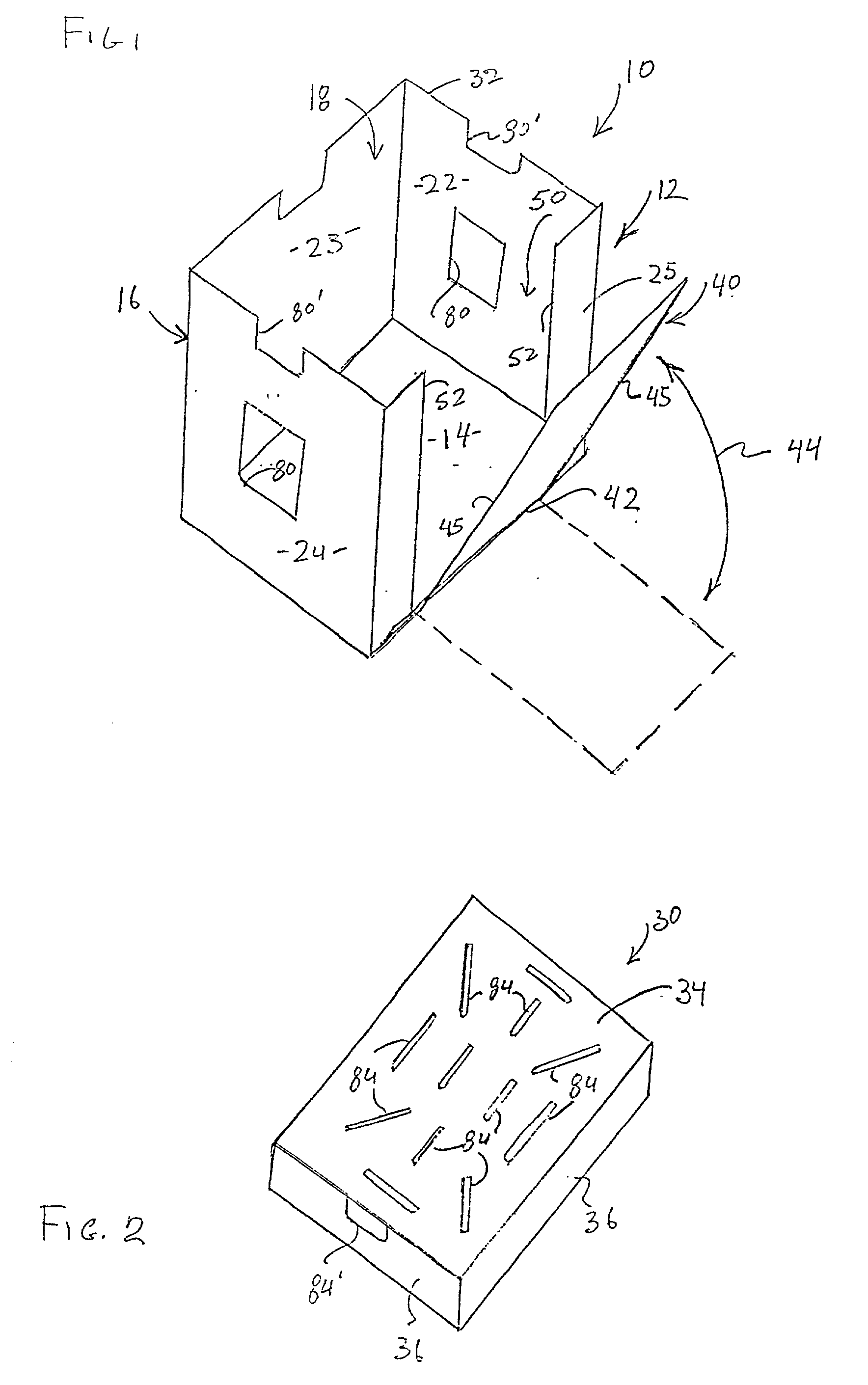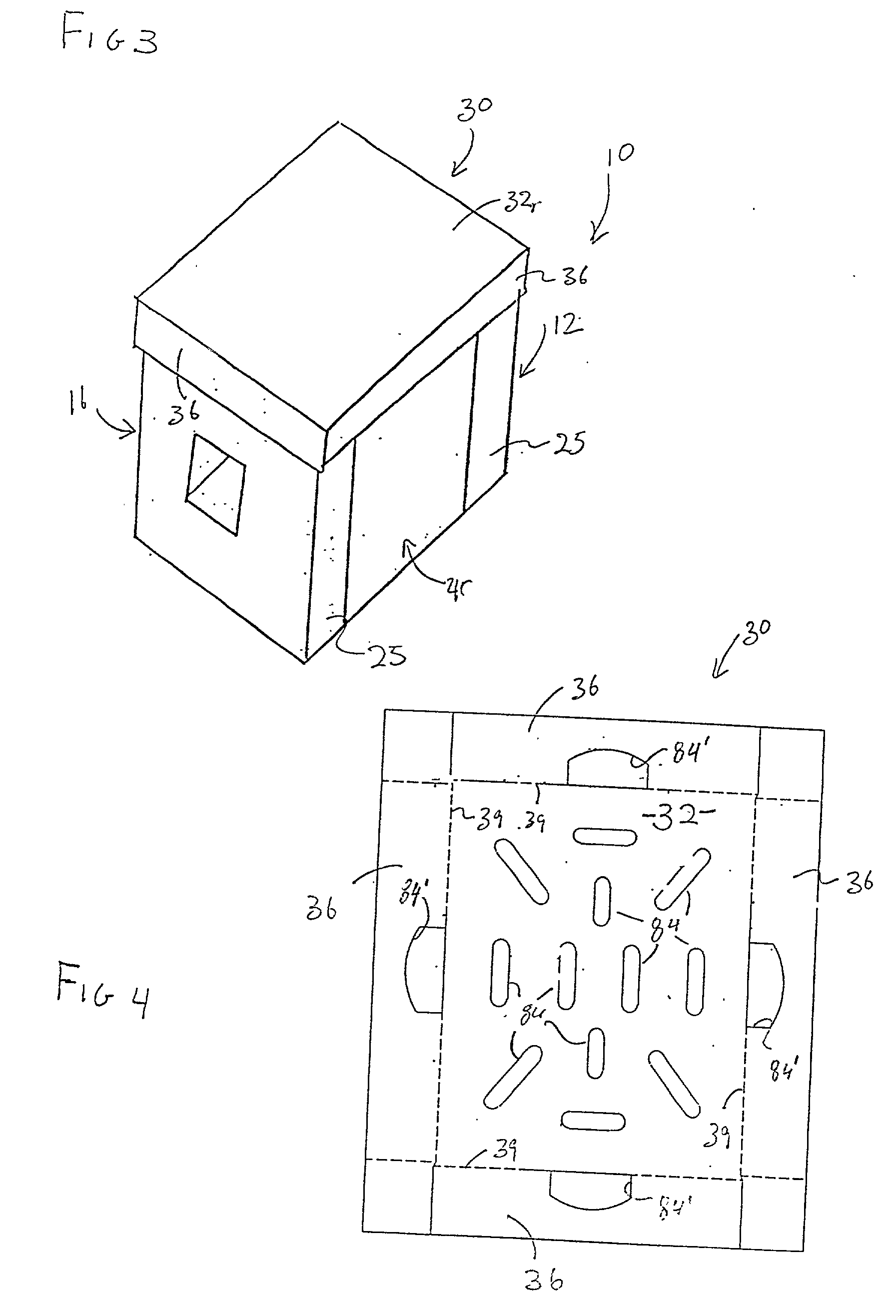[0012] The present invention is directed to a container assembly which is structured to contain, during storage, transportation and display, a variety of different products which are commonly related by the fact that such products are relatively fragile. However, it is emphasized that the container assembly of the present invention is readily adaptable, with little or no structural modification, for the containment of any number of relatively sturdy or fragile products. Therefore, the structural features incorporated in the subject container assembly, as will be explained in greater detail hereinafter, facilitate the safe, secure and efficient positioning of the products, especially during the loading and un-loading procedures. More specifically, the placement within and removal from the container interior is accomplished in a manner which eliminates or significantly reduces the possibility of physical damage being done to the individual products, due to the their engagement or contact with one another or with interior surface portions of the container assembly.
[0015] Another feature of the present invention is particularly directed to the structuring of the body, including the sidewall assembly and base, in such a manner as to facilitate positioning of contents within and removal from the hollow interior thereof during packing and un-packing. Moreover, product positioning may be easily and efficiently performed in a manner which eliminates or significantly reduces the possibility of physical damage being done to the products or contents.
[0017] Accordingly, the container assembly of the present invention, comprises an access segment movably connected to or mounted on the body and selectively positionable between an opened position and a closed position. In the opened position both visual and
physical access to the hollow interior of the body, and the contents contained therein, are facilitated. Further, when the access segment is disposed at least partially or completely in the opened position, an access opening is created in the body. The creation or establishment of the access opening occurs upon displacement of the access segment, outwardly from the sidewall of the body or other portion thereof in which it is formed and with which it is aligned when in its closed position. Therefore, the periphery of the access opening substantially corresponds, along at least a significant portion thereof, to the
peripheral edge of the access segment thereby facilitating re-alignment between the access segment and the access opening when the access segment is again disposed back into its closed position in co-planar relation with the sidewall or other portion of the body from which the access segment is formed.
[0021] Yet another embodiment of the container assembly of the present invention is structured to include all the physical and operative characteristics and attributes as set forth above, but additionally facilitates the display of the products contained within the interior of the body. Also in this preferred embodiment of the present invention, the products are easily displayed by enhancing both the visual and
physical access to the products, through the access opening formed in the sidewall, or other portion of the body. At the same time it is assured that the products are safely retained within the interior, even when the access segment is disposed in the open position for display.
[0022] To further enhance the aforementioned visual and physical access to the products within the interior of the body, and to maintain the laterally directed positioning of the products into and out of the body, the opened position of the access segment may assume a variety of different orientations. More specifically, the access segment or a significant portion thereof may be entirely removed from the body, thereby permanently establishing the access opening. Alternatively, the open position may be defined by the access segment folded outwardly from the sidewall of the body along a plurality of connecting seams, creases, fold lines or the like. However, each of the aforementioned seams or fold lines, about which the access segment may be pivoted, is disposed in spaced relation to the bottom or base of the body. By virtue of this positioning of the fold lines, a significant portion of the sidewall remains and extends upwardly from the base so as to further aid in maintaining the objects on the interior of the body during the
visual inspection or display. However, the presence of this additional sidewall section does not inhibit the laterally directed positioning of the products into and out of the body interior.
[0023] Therefore, the container assembly of the present invention, including the various embodiments thereof, overcomes significant and long recognized problems existing in the storage, shipping and display of fragile products such as, but not limited to produce, flowers, and the like. In addition, physical damage to the products, especially during the loading and unloading procedures, is eliminated or significantly reduced by laterally directing, as versus vertically directing, the positioning of the products into and out of the hollow interior of the container.
 Login to View More
Login to View More  Login to View More
Login to View More 


